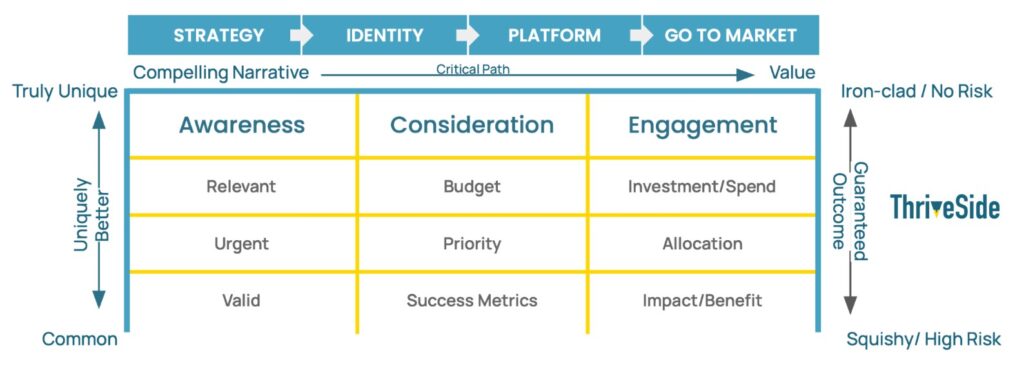
Most of you don’t fail because they lack a great product, brilliant founders, or access to capital. You fail because you haven’t worked out how to tell your story. You fail because your narrative doesn’t build trust, urgency, or credibility; three things that must happen before you ever get to the sale.
This isn’t just a founder problem. It’s an ecosystem problem. Cities, startup communities, universities, and governments keep trying to “sell” innovation without actually earning belief. We subsidize accelerators, preach about entrepreneurship, throw conferences, only to watch investor capital, top-tier talent, and scalable startups leave for markets that feel more credible.
It’s not because they’re better. It’s because they’re clearer.
Following our popular perspective on Why Nobody Understands Startup Growth, I sat down with David, Daniel, and Nick with Founder’s Best Friend again to talk about ACES: Awareness, Consideration, Engagement, Sales – isn’t a sales funnel. It’s a system for constructing narrative credibility. It’s not a tool to close deals. It’s a map of why no one believes you in the first place.
Article Highlights
Fix your startup strategy—before bad advice ruins it
Entrepreneurs and Ecosystems Don’t Have a Sales Problem, They Have a Narrative Problem
If people aren’t engaged with what you’re building, it’s because they don’t understand it, don’t trust it, or don’t believe it’s for them.
What most call a sales or even marketing problem is almost always one of the following:
- No one knows you exist (Awareness gap)
- No one understands what you do or why it matters (Consideration gap)
- No one believes you can deliver (Engagement gap)
By the time you realize no one’s buying, sponsoring, or investing, you’re already late. A sale is just the outcome of everything else working. Appreciate this: when’s the last time you bought something expensive, complex, or career-risky because of one clever pitch? You didn’t. You bought because the solution, event, or move to a city felt reliable, necessary, and inevitable. That’s not a sale. That’s narrative trust.
Founders and ecosystem builders mistake visibility for resonance. They confuse buzz for belief – you know what I’m talking about, your city seems like a startup hub because of the hype. And ecosystems all repeat the same sin, thinking that building coworking spaces or hosting pitch competitions is the same as building reputation and legitimacy.
This is why early-stage traction is so elusive to startups. It’s not just product-market fit you’re missing. It’s narrative-market fit. If your story doesn’t resonate with how your audience sees their problem, you’re not just unclear, you’re irrelevant.

Why Startups Fail to Gain Traction
The ACES model (Awareness – Consideration – Engagement – Sales) is a narrative architecture designed to build belief that compounds. That arrow in the diagram isn’t a funnel. It’s a credibility escalator. Skip a step, and the whole thing collapses.
Let me explain from my perspective of the model:
Awareness
The goal here is not exposure. It’s relevance.
- Valid: You’re addressing a real issue in a real market.
- Urgent: You’re showing that the problem is timely and costly.
- Relevant: You’re positioning your venture in a way that resonates with the buyer’s worldview.
This is where founders often flame out. The message isn’t wrong, it’s just not urgent. You’re broadcasting a feature when they need a reason to care. If the world sees you as common or risky, you’re living in the bottom-left quadrant of the model: commodity purgatory, a feature not startup, or you just clearly didn’t talk to people during market validation.
Consideration
Now we move from “what is this?” to “should I care?”
- Success Metrics: Can they see a path to measurable improvement?
- Priority: Is this a top-3 problem or a “someday when we have time” idea?
- Budget: Do they have (or can they find) the resources to work with you?
Here’s where most deals die not because the product failed but because the founder didn’t create clarity. In fact, this is usually why Product or Engineer oriented founders fail; you know you have a solution that works and is better — SO WHAT?? You didn’t show why this is worth their time, effort, or internal political capital. The burden is on you to anchor the value.
Engagement
This is the phase of risk removal.
- Impact/Benefit: The outcome is visible and meaningful.
- Allocation: They’re willing to shift internal resources.
- Investment: They’re ready to act.
If you’re here and still not closing, it’s not about sales technique. It’s about trust. Too often founders disregard that they have competition and that consumers consider what’s known as a switching cost (sure, yours is a bit better, but I have to switch from what I have now). Did your story build the kind of conviction where your buyer can make a move that won’t come back to haunt them?
Sales
Finally, we arrive at the “S” in ACES: Sales. Take note that it is at the end of the acronym ACE because almost all of you (and worse, advisors and investors) push sales FIRST, or as evidence of traction, and yet if you haven’t nailed down Awareness, Consideration, and Engagement, you are cold calling leads that don’t care and sales is a b.s. indicator of validation.
Here, at the end of ACE, you’ve earned the right to pitch, close, or convert. But that outcome (be it a purchase, a partnership, or adoption) should feel like the natural result of a structured, confident journey. Not a closed sales pitch.
We refer to ACES as a sales model but what you need to understand is that it’s because sales are the culmination of a narrative that works. If you skip ahead to pitching before you’ve walked your audience through the ACES path, or without being unique or having a guaranteed outcome, you’re not just rushing the process, you’re losing the deals even though you are talking to customers and closing some.
Beyond Startups: ACES Applies to Ecosystems and Economies
ACES is a framework your ecosystem builders, economic developer, investors, universities, and government officials should understand, because narrative is economic infrastructure.
Just look at Texas.
From the outside, it looks like a success story: no income tax, booming population, major cities, supposed startup hubs, and tech moving here. But internally, Texas is in a narrative crisis. Capital is abundant but directionless, governance is often shortsighted, and prosperity is increasingly misaligned with the lived experience of most Texans. In other words, the story of Texas is no longer matching the reality.
Sound familiar? It should, this is what I see happening in almost every city and country in our work. You SAY what you want it to be, and the community ends up believing it’s so, until it’s evident that it isn’t.
Ecosystems follow the same ACES path:
- Awareness: Are we even on the map?
- Consideration: Do investors, founders, and talent see us as a viable place to build? Likely not.
- Engagement: Are they showing up, allocating capital, moving teams?
- Sales: Are they putting down roots and staying? Are businesses sponsoring programs and events?
If you’re an economic development official or policymaker trying to “attract innovation” but you can’t clearly articulate the ACES path for your region, don’t be surprised when the startups don’t come, and the ones that do, leave.
Incidentally, yes, we know why investors aren’t considering you viable. We know why they aren’t allocating capital.
Read more: Why Venture Capital Avoids your Startup Ecosystem
Want to fix that? Stop asking what incentives or programs to launch. Start by asking: Do people even believe us yet? If the answer is no, you’re not in a sales problem. You’re in a narrative gap. And the only way out is clarity.
Where You Are Breaking Down
This is not a sales tool but if you even find yourself reading this, hoping you’ll get sales or close business, you’re missing the point and that is why you’re breaking down. This is a diagnostic for narrative health and I guarantee you are not healthy . Apply it to your startup. Apply it to your city. Apply it to your industry.
Where are people falling off? Where does trust falter? And what are you doing, not to push them down a funnel, but to earn their belief at each step?
If your growth strategy skips this kind of analysis, then don’t be shocked when your “sales problem” turns out to be structural. What part of your narrative do people not believe yet and why?
If you don’t know, you’re not selling. You’re guessing.




Yes. If people don’t understand your story, they can’t trust it, and they’ll never buy in… no matter how great your product is.
Would love for my friends in sales, revenue and growth to weigh in here. Jeff Dyck Jessica Allen Paige Velasquez Budde Doug Bain Doug C. Mark McIntosh Andrew Fox Joe Dauskurdas Jeremy McNeese Jeremy Self
Nicholas Alter I’m curious from this esteemed group, where is the hand off from “Marketing” to “Sales” or does everyone have a better distinction?
Nicholas Alter No trust, no sale. Like the idea of “narrative-market fit.” If people don’t believe your story, they won’t buy, invest, or engage. Thanks for reframing the real problem so clearly.
? This hits harder than most startup “advice” floating around.
Too many founders (and ecosystems) keep mistaking visibility for resonance. But if no one believes you no one buys, period.
The ACES model (Awareness, Consideration, Engagement, Sales) isn’t just a funnel. It’s a narrative credibility check. Most startups don’t have a sales problem, they have a story problem. Most cities trying to be “the next Austin” or “Silicon Valley” don’t have a capital problem, they have a belief problem.
If your message doesn’t create urgency, clarity, and trust, then your pitch, no matter how slick, is falling flat.
Narrative isn’t fluff. It’s infrastructure.
Great read per usual. More founders and ecosystem builders need to tattoo this on their forehead.
John Zozzaro Appreciate that because yes: narrative is infrastructure.
Founders build products for user needs but forget to build belief for buyer risk. And cities throw millions at visibility without anchoring a reputation that actually compels anyone to stay, build, or invest.
We don’t need more funnels. We need clarity that earns movement.
The model is just a mirror: if people aren’t advancing through Awareness, Consideration, and Engagement, the sale was never real. And if you’re closing deals but not scaling, odds are you’re converting despite your narrative, not because of it.
Well said. Like you said, this framework isn’t just important with sales. It’s a useful tool to evaluate ecosystems, policies, etc. It seems simple, but obviously simple isn’t easy.
Right on, Paul. We see it all the time. Startups stall not because of weak products, but because no one understands, connects with and believes their story. ACES provides a framework and fix for founders and teams stuck spinning their wheels.
“You fail because your narrative doesn’t build trust, urgency, or credibility” yes to this. TRUST and CREDIBILITY are critical not only in the beginning but every day going forward!
100% yes Paul O’Brien ? No matter where we sit in the system or funnel…we are pre-conditioned to remember stories. Narrative isn’t about the rote memorization and regurgitation of facts. It’s about delivering an relatable idea with connection, coherence and clarity. It continues to be boggle my mind how easy of a concept this is, and yet how many organizations still get it so wrong. But it’s certainly good for business 😉
Great post.
Founders don’t lose because they failed to sell. They lose because people never believed their story was worth buying into.
Paul O’Brien Nicholas Alter
Interesting reframe from “funnel” to “credibility architecture.”
But trust isn’t built through stages—it’s built through stories.
When we launched Big Five Capital during peak ERTC confusion, everyone else was exploiting the chaos. We said “this market is full of BS, here’s what’s actually true.” That vulnerability became our differentiator.
Your framework assumes linear progression, but real trust is multidimensional. Sometimes you START with engagement (bringing someone into your chaos) and awareness follows. Sometimes they trust you before they understand you.
The cities/startups parallel is smart, but both fail for the same reason: they’re performing competence instead of demonstrating character.
When’s the last time you told a prospect “Actually, you’re not ready for us yet”? That’s where trust begins.
Best sales I’ve made started with “Here’s where we’re weak…” Best partnerships began with “I don’t fully understand your world, help me see it.”
Maybe the framework should be FACE: Fragility, Authenticity, Connection, Exchange….(okay that acronym needs work )
Jeff Dyck FACE the truth, I’m on board
Paul, this framework nails a critical gap many founders and ecosystem builders overlook. Trust and credibility truly are the foundation for sustainable growth, yet so many get stuck trying to push sales before the narrative is fully formed and owned. The distinction between funnel and “credibility architecture” is spot on; it reframes growth as a deliberate, stage-driven process that demands nuanced storytelling and audience insight at every step. Too often, teams mistake reach for relevance, and that’s where momentum stalls. Your call to diagnose where belief breaks down is the kind of strategic rigor the startup world desperately needs.
Stephanie you’re right, most of the damage happens when founders confuse motion for momentum. A funnel without credibility architecture is just noise in the system; it collects leads but doesn’t build belief. What struck me in working through this is how diagnosing where belief breaks is often more valuable than pushing harder at the top of the funnel. If you can see whether it’s Magnetic, Strong, Weak, or Objectionable that’s failing you, the path forward gets a lot clearer and growth feels less like gambling and more like compounding. Nicholas Alter thoughts?